RENEGADE GARDENER™
The lone voice of horticultural reason
The 2006 Renegade Gardener High Spot / Black Spot Awards
12-20-06– A GRACIOUS GOOD EVENING ladies and gentlemen, fellow Renegade Gardeners, and all fair comrades around the globe. I come to you tonight live from the newly re-paneled basement rec hall of the St. Francis Lutheran Church in beautiful downtown Red Wing, Minnesota, site of the 7th Annual Renegade Gardener High Spot/Black Spot Awards.
May I add a special “hello” to the fine members of the Ontario Perennial Plant Producers Association joining in on the excitement this year via our first-ever podcast, something we all agreed was a far finer mode of inclusion than the mess incurred last year when they attended these award ceremonies in person, drank up the town of Tofte before noon, heckled, belched or snoozed their way through the opening ceremonies, then stormed the stage when the Perennial of the Year Award went to Terra Nova’s Heucherella ‘Stoplight’ instead of their very worthy entry, Aruncus dioicus ‘Robertson Davies.’ And how they snuck in that chimpanzee under my nose, and how that chimpanzee gained access to a loaded firearm, is something that I, the wife of the deceased, and the Chief of Police of Tofte, Minnesota, would still like to know more about.
My goodness, has it been seven years? I don’t know what’s more surprising, that the awards ceremony gains a larger global audience each year, or that I haven’t been shut down by attorneys representing half the garden product manufacturers in America. Regardless, what’s important is that the Renegade Gardener High Spot/Black Spot Award has emerged as the single most nugatory merit of achievement in our grand industry.
The envelopes, please …
High Spot Award
Best Gardening Book: Green Roof Plants
A Resource and Planting Guide
Edmund C. and Lucie L. Snodgrass (Timber Press)
 Green roof gardening—placing plants, not asphalt or shingles, atop commercial and residential buildings—is all the rage. One always need take care, of course, when assessing the ultimate worth of what is all the rage at any particular moment in the American gardening scene. Five years ago, gerbera daisies were all the rage, and we’re just now shaking off that hangover.
Green roof gardening—placing plants, not asphalt or shingles, atop commercial and residential buildings—is all the rage. One always need take care, of course, when assessing the ultimate worth of what is all the rage at any particular moment in the American gardening scene. Five years ago, gerbera daisies were all the rage, and we’re just now shaking off that hangover.
But this is a splendid rage, for the premise is that whenever you construct a building you wipe out a footprint of the planet’s flora. Top off the building with a green roof, however, and you replace nature’s lost footprint.
Advantages to the planet, to people, and to future generations are prolific. Aesthetically, we begin ridding the planet of acres of ugly, flat roofs, while combating the growing negative impact of the urban heat island effect. The adjustment made possible in water runoff—minimizing it in some cases, purifying it in all—is substantial. Improvement in air quality, particularly in urban areas, where fume-belching asphalt, tar, and other forms of roofing materials are replaced by air-purifying plants calls forth visions of nirvana. Slam-dunk stuff.
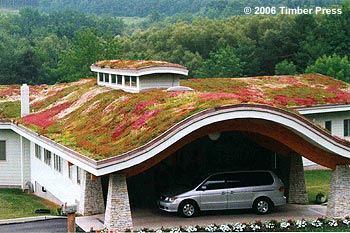 |
| Chiropractic office, Hazelton, Pennsylvania. |
Ten years ago, green roofs in America were rare, usually little more than a few square feet of creeping sedums or Rosularia (hens and chicks) covering the mossy roof of an avid gardener’s potting shed. Today, green roofs across the US—including big ones—number in the hundreds, approaching the thousands.
From the book: “…successful installations can be found around the United States and Canada, ranging from private homes, to universities and colleges, to large corporations such as Gap, Inc., and the Ford Motor Company. And increasingly, federal agencies and institutions in the United States, including the Department of Defense, the National Institutes of Health, and the Library of Congress, are also sporting green roofs.”
As one might guess, creating a green roof involves much more than simply spreading dirt instead of roofing material, and plunking the thing full of plants. In clear, concise prose, the book covers pertinent engineering and technical considerations in detail, and is filled with excellent, full color photos not just of completed green roofs but projects under construction.
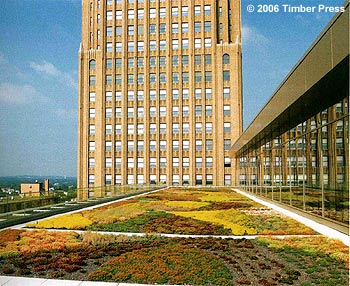 Every question I had—growing medium composition and depth, drainage and underlayment, insulation, load considerations, roof slope/pitch factors (yes, you can “go green” on a sloped roof)—were covered.
Every question I had—growing medium composition and depth, drainage and underlayment, insulation, load considerations, roof slope/pitch factors (yes, you can “go green” on a sloped roof)—were covered.
Covered equally as succinctly is the topic of vegetation and plant selection, including installation, plant establishment, and maintenance. This chapter segues into the second half of the book that serves as a most complete catalogue of the wide variety of plants that will thrive on green roofs—annuals, herbaceous perennials, hardy succulents, grasses, herbs, natives, even bulbs, corms and rhizomes. And the authors didn’t neglect us true gardeners in Zones 3 and 4! That’s nearly a first.
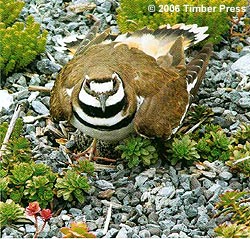 |
| Killdeer nesting on green roof, Washington, D.C. |
Edmund C. Snodgrass is a preeminent expert on green roof technologies, started the first green roof nursery in the U.S. and has collaborated on green roof research with numerous colleges and universities. Lucie L. Snodgrass is a passionate gardener and, luckily for Edmund, a first-rate professional writer.
The two have combined to create a helluva book, comrades. After reading it, you could go out and create a successful green roof atop your new garage—or the new Target corporate office building in downtown Minneapolis.
Now there’s an idea …
Black Spot Award
Worst Press Release: Schultz Communications, “Year-Round™ Spray Oil”
This public relations firm represents a large handful of garden product manufacturers, and sends out press releases that often contain valid news of clients’ products that add to the value of the gardening experience. What caught my eye when I received this one, however, was the blaring headline: KILL LATE-SEASON INSECTS WITHOUT DANGEROUS CHEMICALS. The release went on to tout the wisdom and ease of using, “ A new generation of lighter, highly refined horticultural oils …”
I sensed I was once again about to enter into that sleight-of-hand state where garden product marketing experts imply that “chemical” may only mean “synthetic”—you know, those evil poisons made by white male Republicans in lab coats—and that this product (no doubt “organic”) was an oil, therefore not really a chemical, nor was it “dangerous.” And I was right.
Repeat after me: It’s not organic products versus chemical products, it’s organic chemical products versus synthetic chemical products. Both are always chemicals.
A quick perusal of the client’s website, The Summit Chemical Company, unearthed the following copy from the product’s label warning. I hope your computer screen is wide enough:
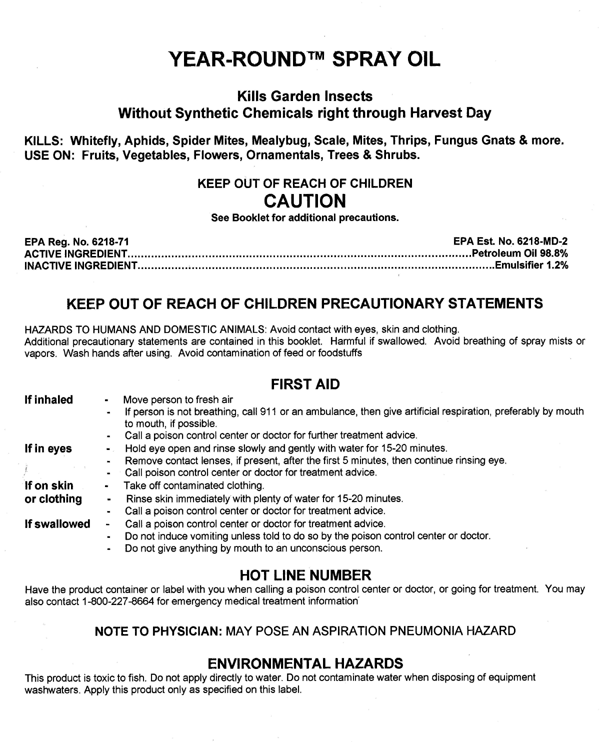
Taken from the top, Year-Round™ Spray Oil claims, no doubt accurately, that it “Kills Garden Insects Without Synthetic Chemicals right through Harvest Day,” the technical writers at Summit obviously better versed in facts surrounding chemicals than the PR people who rewrite this stuff for consumer consumption.
Literal consumer consumption of the product, of course, would be a dangerous act indeed, for as you can see, the active ingredient is 98.8% petroleum oil. It’s organic, alright—comes from rocks. And like nearly every chemical—organic or synthetic—that kills something, it is a hazard to humans and domestic animals, and flat-out toxic to fish. By the way, if you were to spill a full bottle of the stuff on the ground, that wouldn’t be too good, either. You sure wouldn’t be able to grow anything there without digging up and replacing the soil.
The First Aid instructions are fairly standard, if inhaled call a poison control center, if person is not breathing call 911, if splashed rinse eyes for 15-20 minutes, rinse skin immediately, if swallowed do not induce vomiting, etc., followed by that stern statement of Environmental Hazards. Jeez Louise, the press release said this was not a dangerous chemical—it’s an organic oil, you see.
Funny thing is, Summit is a good manufacturer, and an environmentally astute corporate citizen. They were instrumental in the development of a Bti-based mosquito control product (Bti stands for Bacillus thurengiensis israeliensis, an organic, highly toxic bacteria) of great aid to consumers—and our American soldiers. The US Department of Defense buys and uses the product, Bti Briquets ®, to protect troops at home and abroad from mosquito borne illness. Since its inception, Bti Briquets have been effective in controlling mosquitoes and combating the spread of malaria and dengue fever in the U.S. and developing nations.
That’s a good story. Why PR firms need to shuck and jive and add confusion to fact annoys me. By all means, ask for and use Year-Round™ Spray Oil to control garden pests, if you are a gardener who uses chemicals. Just be careful to follow label directions, and try not spray “good” bugs, because just like any synthetic chemical-based pesticide, this stuff will kill them dead as hell.
High Spot Award
Shrub of the Year: Salix integra ‘Hakuro Nishiki’ ( Willow)
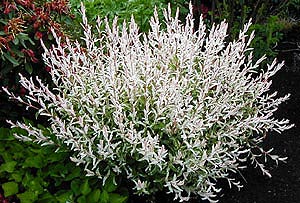 Willows are outstanding, versatile shrubs that Zone 3-5 gardeners should explore. Of late, smaller varieties have become available in the trade, and of these, Hakuro is my favorite.
Willows are outstanding, versatile shrubs that Zone 3-5 gardeners should explore. Of late, smaller varieties have become available in the trade, and of these, Hakuro is my favorite.
It’s an arresting, graceful shrub of delicate, petite appearance. Buy a small one (placing it with its mature height and width of about 5’ x 5’ in mind) because the first few seasons in my garden it reminded me of that really good young child actor, what’s her name, she was in “I am Sam” (an underrated Sean Penn movie) and “Man on Fire,” another good movie…Dakota Fanning. Growing ‘Hakuro Nishiki’ is like waking up and seeing Dakota Fanning standing silently in your garden. It’s just gorgeous, somehow emitting depth and meaning.
Leaves are slender, light green mottled with pink and cream. Just as gorgeous as jewelry when they emerge and develop in spring. Stems and buds are salmon pink in spring, and in winter, stems from the current season turn coral red. Flowers are insignificant, but who cares.
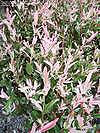 There is a tree form now available, Hakuro grafted on a standard, they look darling, I planted one for the first time just this past summer, so have no views on how well the tree form handles Zone 4 winters, but it is supposed to.
There is a tree form now available, Hakuro grafted on a standard, they look darling, I planted one for the first time just this past summer, so have no views on how well the tree form handles Zone 4 winters, but it is supposed to.
Plant in full sun in decent soil and keep it watered. It’s a willow, so it grows fairly quickly, but is best grown (in Zone 4) in a protected spot, and mulched for winter. Winter dieback in the north is not uncommon, but that’s a benefit—it just means that in spring it starts over from the base up, and doesn’t develop a lot of older, woody stem growth. Northern gardeners may grow it and find it never gets much taller than four feet. You see Hakuro in gardens in Zone 7, Portland, Vancouver, and they get much larger, a bit gangly, still graceful and pretty, but to my eye the large size of the shrub gets out of proportion to the slender leaves. I think they look prettier in Zones 4 & 5.
Willows, willows, willows. If you want huge in the north, check out Salix ‘Flame,’ it was discovered by an astute gardener in southern Minnesota and was named in accord with its intense orange-red winter stem color. It will hit 20’ tall by 20’ wide. Hardy to Zone 3 (hello, Winnipeg). Solid green leaves but nice yellow fall color. There’s another Zone 3 variety, Alpine (Salix yezo-alpina) that’s an excellent groundcover, twelve inches high spreading four to five feet, tolerates part shade.
 |
| Arctic Blue Leaf Willow |
Arctic Blue Leaf (Salix purpurea ‘Nana’) is a gorgeous upright small willow, 3-6’ H x 3-6’ W, an excellent hedge plant that tolerates heavy pruning. Finely textured, blue-green leaves and deep purple twigs. The new kid on the block is ‘Canyon Blue,’ a selection of Arctic Blue Leaf with silver-blue foliage on wispy, mahogany stems. Both are hardy to Zone 4.
There aren’t a lot of slender, small-leaved shrubs to choose from; willows will give your landscape mosaic the delicate textural twist it may be lacking.
Black Spot Award
Biggest Sign that the Gardening Industry Just Doesn’t Get It:
Trade Article, “Is Gardening Dead?”
In May of this year I published an article on the site titled, “Is Gardening Dead?” In it I gave my views on causes for the downward trend in gardening industry sales over the past three years. Just a few weeks later, an article with the same title appeared on Ball Publishing’s online industry magazine, GrowerTalks.
I’m sure the writer’s use of the same title was coincidental. There, however, is where coincidence ends.
The GrowerTalks article is filled with research and ideas gleaned from industry experts and nursery owners. Early stuff caught my eye, such as the statement that perhaps nurseries should consider the concept of plants as “indoor/outdoor décor” and promote a plant’s use as “a decoration rather than a landscape element,” because, “the intimidation factor will go down.”
Advice from one nursery owner in Ireland, whose falling sales mirror the trend in the U.S., was also included in the article, as follows:
He’s gotten rid of all Latin botanical names on signage, and has begun focusing on signage “using emotional language to promote and sell color.” Lord knows you don’t want consumers discovering that gardening might involve activation of their brains. He’s taken to selling all his houseplants in trendy, colorful pots, and has found that if the public perceives that they are buying the plant and the pot, “there’s less of a problem if the plant dies.”
His final comment: “The future (of our industry) is about people AND gardens—not teaching people to garden.”
Doomed, I tell you, doomed. To read my article “Is Gardening Dead?” click here.
High Spot Award
Best News: Increase in Plant Prices at Box Stores
I rail against the big box stores, join the national chorus of purists who rip Home Depot, Loews, Wal-Mart and the rest for selling plants at such low prices that independent nurseries who offer better help and better plant quality can’t compete.
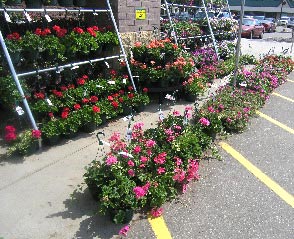 But there are signs that the playing field may be leveling, and that’s blessed relief. This year, around the country, reports are that many of the big box stores raised prices to the extent that they were no longer severely undercutting the small, specialty nurseries. In fact, in one instance in Columbus, Ohio, the Home Depot was charging prices substantially higher than the independents on certain potted annuals.
But there are signs that the playing field may be leveling, and that’s blessed relief. This year, around the country, reports are that many of the big box stores raised prices to the extent that they were no longer severely undercutting the small, specialty nurseries. In fact, in one instance in Columbus, Ohio, the Home Depot was charging prices substantially higher than the independents on certain potted annuals.
Factors for this pendulum swing are many, but those based on laws of economics are most welcome. In years past, prices I’ve seen at local box stores for annuals (I never buy) can be so ridiculously low I suspect the profit margin is paper thin, or, very probably, the week’s advertised specials are loss-leaders. Maybe what’s happened is that the big chain retailers have ended their planned period of super-low prices, and, having trained the public to buy their plants at the same place they buy their plywood or plastic lawn furniture, they’re ready to increase their profits.
That’s good, because small, often family-owned nurseries, the kinds of nurseries that offer a more thoughtful plant selection and do more to develop true gardeners, have been taking a beating. To some degree, perhaps the hue and cry of the media, telling consumers they should consider plant selection, health, and staff knowledge instead of mere price when buying plants, has also had impact. I think because of this, big box stores are slowly developing real garden staff, and investing more in plant care, factors that would also lead to raising their plant prices up into the realm of reality.
I still don’t support them, but I support the trend.
Black Spot Award
Worst News: The Closing of Heronswood Nursery
Due to my cluttered summer resulting in intermittent updates I never got around to reporting this very sad news. Those of you Renegades introduced to Heronswood via this website and who have purchased their plants via mail order understand that from a perennial selection standpoint, things will never be the same.
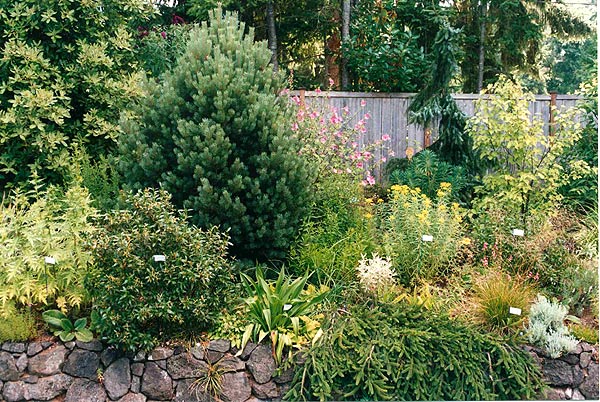 |
| All photos Heronswood display gardens. |
Heronswood (located outside Seattle) was a nursery/botanical garden that turned out to be too good to be true. A Pacific Northwest institution for nearly 20 years, in May of this year all operations were shut down by its corporate owner, W. Atlee Burpee & Company. Among gardeners in the know, Heronswood had become the premier specialty perennial nursery in the nation. Martha Stewart was a regular visitor, as were tens of thousands of Northwest gardeners who over the years marveled at the diversity of its collection—some 6,000 types of plants.
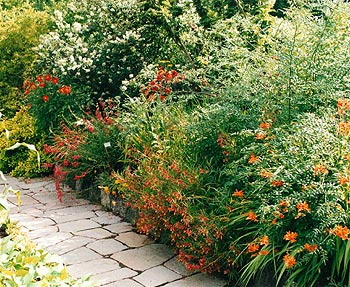 The lovechild of founder and international plant collector Dan Hinkley, each year’s Heronswood catalogue—quirky, voluminous, in black and white, sans pictures and personally written, wonderfully, by Hinkley—would introduce gardeners to literally thousands of perennial varieties available nowhere else, many collected by Hinkley from wilderness areas around the globe, and previously found only in the wild, or distinguished European arboreta.
The lovechild of founder and international plant collector Dan Hinkley, each year’s Heronswood catalogue—quirky, voluminous, in black and white, sans pictures and personally written, wonderfully, by Hinkley—would introduce gardeners to literally thousands of perennial varieties available nowhere else, many collected by Hinkley from wilderness areas around the globe, and previously found only in the wild, or distinguished European arboreta.
Economics, in this case most unfortunately, was behind the decision, for Heronswood was never profitable, even after being purchased by Burpee in 2000. With a majority of the perennials hardy only to USDA Zones 6 or 7, the nursery, while internationally know, lacked the wherewithal to attract a large enough U.S. and Canadian clientele.
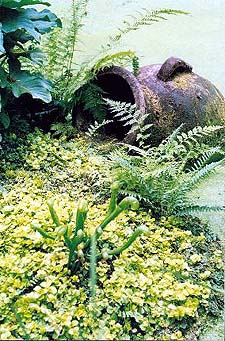 I had the opportunity to tour Heronswood’s impeccable display acres five years ago, unaware that I was literally stepping through an endangered species. In breaking news, The Pacific Northwest Horticultural Conservancy (PNHC), a non-profit organization, has just been formed with the mission to acquire and preserve this internationally renowned botanical garden and plant collection at the former nursery property.
I had the opportunity to tour Heronswood’s impeccable display acres five years ago, unaware that I was literally stepping through an endangered species. In breaking news, The Pacific Northwest Horticultural Conservancy (PNHC), a non-profit organization, has just been formed with the mission to acquire and preserve this internationally renowned botanical garden and plant collection at the former nursery property.
The goal is to establish a community-based, self-sustaining horticultural research and education center, collaborating with educational institutions such as the University of Washington and Olympic College. For updates and information on how you can become involved, visit weloveplants.org.
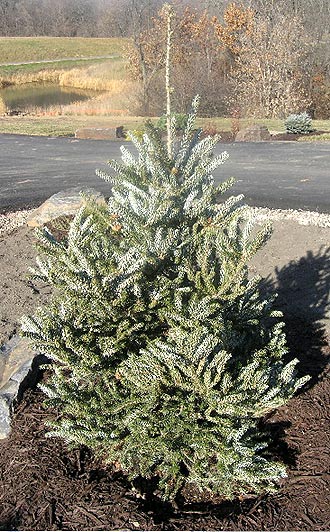 High Spot Award
High Spot Award
Tree of the Year: Abies koreana ‘Horstmann’s Silberlocke’ (Fir)
What is lovelier to nurture and grow than an evergreen tree? And is there a more beautiful evergreen tree than this?
Oh, probably, but this year’s RG Tree of the Year has become so indispensable to my way of thinking and designing that it merits this award and more. Horstmann’s is a jewel, a small, compact evergreen that performs equally well in full sun to part shade (you part-shade denizens, this is why you need to know your firs). Direct sun in morning, afternoon shade, or vice versa (or a nice four- to five-hour blast of sunlight midday) and this tree will sparkle and shine.
Relatively small (20-25’ H x 10-15’ W, at maturity) with irregular branching, plant this tree and you’ve started a true evergreen collection. Bright purple-violet cones grace the tree through summer, and year ‘round the tightly curling needles show off their silver underside. It’s rock hardy to Zone 4, with no winterburn if grown properly and watered in fall up to ground freeze. I hit all my evergreens, once, with a granular fertilizer in spring.
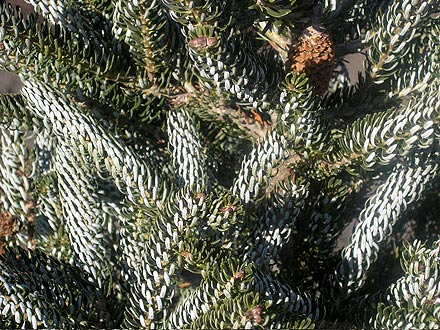 It’s a fir, so you want slightly acidic soil that drains well and contains moderate organic content. Mulch it and don’t let it ever completely dry out (true of everything we grow, I guess except for you TX/NM/AZ readers). Breathtaking the minute you step back from planting, in five or ten years—oh my.
It’s a fir, so you want slightly acidic soil that drains well and contains moderate organic content. Mulch it and don’t let it ever completely dry out (true of everything we grow, I guess except for you TX/NM/AZ readers). Breathtaking the minute you step back from planting, in five or ten years—oh my.
Black Spot Award
Most Disappointing Book: American Horticultural Society Encyclopedia of Perennials
DK Publishing
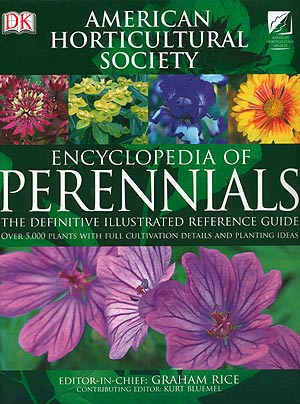 No disrespect intended to Graham Rice, editor-in-chief of this brand-new, large, heavy, expensive hardcover encyclopedia being touted as the scrumptious, complete A-Z compendium of perennials that devout American gardeners have been yearning for.
No disrespect intended to Graham Rice, editor-in-chief of this brand-new, large, heavy, expensive hardcover encyclopedia being touted as the scrumptious, complete A-Z compendium of perennials that devout American gardeners have been yearning for.
I try never to insult the British when it comes to gardening.
And British Mr. Rice is, as is a great deal of the photography, writing, and content of this book, being heralded as the definitive U.S. gardening encyclopedia. That it may be, at least to date. But the book is not without its disappointments.
This book was released simultaneously with a strikingly similar British version. The British version of the book is published under the auspices of The Royal Horticultural Society (RHS) and the American version by The American Horticultural Society (AHS). Already, controversy within the usually serene world of the Garden Writers Association swirls around the book, stirred by publication of a letter in our monthly magazine from a member in which he decries the book as a British-born encyclopedia altered—inadequately—for sale to American consumers.
The writer makes several valid points. Responding letters by a representative of the AHS, and by Mr. Rice himself, refute them, and hold steady that the U.S. and British versions stand alone as fair and worthy reference books.
As my father has always advised me, when considering an argument, the truth usually lies somewhere in the middle.
While the AHS is sticking with its story that Encyclopedia of Perennials was conceived and engaged from the onset as a two-book affair, with different contributors from each side of the Atlantic working to produce one book for British (and European) gardeners and one book for American (and, one would hope, Canadian) gardeners, I know enough about the machinations of book publishing to understand the unfortunate compromises that such an enterprise, no matter how well-intentioned, must impose.
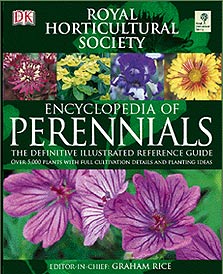 A United States-based plant expert was brought on board and is credited on the cover of the AHS version of the book as Contributing Editor (note the difference in the book covers left and above) and there is no reason to doubt that he did indeed advise and adjust some of the content to better serve an American audience. (In fact, having myself been involved in a similar project of far lesser stature, he probably worked like hell, and wished he’d asked for more money.) In addition, 16 American garden writers and plant experts—the cream of the crop, by the way—were enlisted to help produce the AHS version.
A United States-based plant expert was brought on board and is credited on the cover of the AHS version of the book as Contributing Editor (note the difference in the book covers left and above) and there is no reason to doubt that he did indeed advise and adjust some of the content to better serve an American audience. (In fact, having myself been involved in a similar project of far lesser stature, he probably worked like hell, and wished he’d asked for more money.) In addition, 16 American garden writers and plant experts—the cream of the crop, by the way—were enlisted to help produce the AHS version.
However, any publisher (or writer with experience in the book biz) knows that a duel-book enterprise such as this begins and evolves as either one book or the other. One book is always The Bible, the other The Revised Edition. That’s just the way publishing is. For such an enormously expensive undertaking, one cannot turn garden writers and photographers loose on both sides of the Atlantic, even if divvying up an exacting workload, and profitably produce two books that will be both unique to their disparate readerships and fair in the sharing of common ground.
Let’s just say, the Brits won.
A huge majority of the photography credits for the book are to British photographers and photo agencies. 48 contributing writers and perennial plant experts are credited in the opening pages of the AHS version—the 16 aforementioned American experts, and 32 British. That’s a two-to-one ratio. Who was truly behind the book? I can’t get my hands on a list of the contributing writers and perennial experts credited in the RHS version, but why my sneaking suspicion that the list inside that book is made up of the 32 British experts, and fewer, or none, of the Americans? Must be the sushi.
Does any of this matter if the resulting tome sold on these shores and credited to the American Horticultural Society suffers no slight from being an altered version of what was undoubtedly (come on boys—fess up) a British-born perennial encyclopedia? Of course not. Except that British inception does hinder the content and value of the AHS version of the book.
What’s included in the AHS version is page after page of perennials dear to the hearts of British and European gardeners, such as Luzula, Dactylorhiza, Leonotus (Lion’s Ear, hardy only to Zone 10, for Pete’s sake!) and Ophiopogon, perennials found in European nurseries but obscure to the point of being nonexistent on this side of the pond. Dactylorhiza elata is described as “One of the best garden species…among the easiest and often the least expensive of orchids… ideal first orchids for gardeners.” Good luck scoring a clump stateside. Google it and you’ll find only nurseries in England.
One can argue that if setting out to create an A-Z encyclopedia of perennials, if it’s a perennial, it’s in, so that’s why these genera are included. Except that isn’t how plant books are done—creating an encyclopedia under that rule would result in a book weighing 60 pounds and costing $200. It makes sense to create exhaustive plant books based on continent. But when doing so, decisions about which genera to include and which to omit must be made. That’s the rub here. Too much of this book has decided you’d rather garden in England.
For instance: In neither version is there a section on lilies (Lilium), a bulb plant and mainstay of American gardens. This is an alleged encyclopedia, and this vital genus is not included! Yet calla lilies (Zantedeschia), a Zone 8, tuberous perennial grown by perhaps one in 10,000 American gardeners, are given full treatment in both versions.
Why? Probably because calla lilies are hardy throughout most of England, and are as commonly grown across Europe as Americans grow true lilies.
Perhaps to tidy up the omission, it is stated in the book’s forward that, “The AHS Encyclopedia of Perennials covers only hardy perennials plants. There are no bulbs …” Except that isn’t true. Alliums are included in both versions (and last I checked, I believe they only come as bulbs) probably because alliums are widely grown in Europe. Alliums made the cut, lilies didn’t.
Yes, the book includes plenty of venerable perennials that both we and the British grow. Just be aware you’re paying big bucks for pages of obscure European favorites that are nowhere near as valuable to American gardeners as other genera that are astonishingly omitted, a few of which are Angelica gigas (a perennial I couldn’t live without, hardy from Minnesota to Texas),Opuntia humifusa (hardy perennial prickly pear), Cassia (Wild Senna, sold at specialty nurseries in the Twin Cities but overlooked in this book—a North American native, you see) and Peltiphyllum (Umbrella Plant, Zone 4, Americans grow it, Europeans apparently don’t).
I hope I don’t sound like I’m laying blame. Omitting the dozens of Zone 8 and 9 genera and hundreds of varieties of perennials included in the book that Americans gardeners can’t buy and can’t grow, then adding every useful perennial we can (one of the encyclopedia’s deficiencies is in North American native plants for which cultivars have been developed, particularly native grasses) is way too costly and difficult an undertaking to expect, given the double-duty of the books.
The bottom line is, had an American publisher been the sole instigator—British be damned—and created this book using American perennial experts, writers, and photographers, there can be no question that The AHS Encyclopedia of Perennials would not be the same book that’s now on the shelves at Borders, and would serve American gardeners better.
So is it worth buying? I have to vote “no.” From a national standpoint, Rodale’s Illustrated Encyclopedia of Perennials is a more useful book. Another suggestion is to check your bookstores for regional perennial books that expound upon perennials for your USDA growing zone. These less expensive books can be supplemented with a good book on native North American perennials for your state or region. These are the books you’ll use.
A true and complete encyclopedia of perennials for United States (and Canadian) gardeners remains unwritten.
High Spot Award
Perennial of the Year: Polemonium reptans ‘Stairway to Heaven’ (Creeping Jacob’s Ladder)
Judges had little difficulty agreeing on this one. The longer you live the more you become a shade gardener, so here’s a perennial you will love to grow. For pics and details click Plant Spotlight.
Black Spot Award
Worst Gardening Product of the Year:
Roll Out Flowers Instant Flower Blanket
“Using Roll Out Flowers was the easiest, most successful garden I’ve ever grown. This was truly a five minute garden!”
-From Roll Out Flowers promotional material
Deep breaths, Don, steady, hold your fire, where to start, where to start, where to start…
Maybe with the fact that this product is the embodiment of pure, heinous sin, a gruesome incarnate of evil for which the term “garden porn” suddenly lacks suitable severity. This is the kind of product that makes the Renegade Gardener bow his head at his computer late at night and mutter, “What’s the use?”
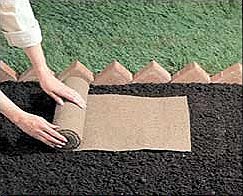 |
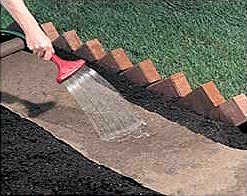 |
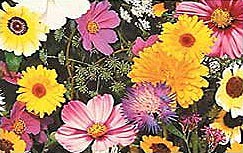 |
What you have here are annual flower seeds sprinkled on a roll of paper. Buy it, unroll it in your yard, water it, and in three to four weeks, a mat of flowers will start to bloom, if the cat doesn’t pee on it.
This, the most coveted of all Renegade Gardener Awards, is actually being awarded to not only the product mentioned above but all additional, annual-seeds-on-a-paper-mat products that have proliferated of late, Roll ‘N Grow, a favorite of late-night infomercials, being one. With a typical roll sized at one foot by twelve, they all sell for around nineteen bucks per roll. I don’t see how manufacturers cost, even with four-color packaging, could exceed two bucks.
Buyers of these products are not learning how to garden and getting ripped off in the process.
Another similar product is named Instant Flower Garden, a butterfly mix, same deal, although a rather paltry mat for eleven bucks after shipping: seven inches by six feet. But remember, per their instructions, “Flowers can be cut to any size.” I assume they are referring to the mat. I wonder, can you cut it any larger?
Here is how the “advantages” of this utter horror show are expressed by one manufacturer:
Planning and growing a flower garden has never been easier! Create an instant flower garden with ease. Just roll and grow! Choose from our four different varieties of flower garden types; Garden Fragrance, Olde English Garden, Shady Garden, and Butterfly/Hummingbird Garden. (Product Name) makes it simple for anyone to start and maintain a lush and hearty garden.
I particularly like this ad because it also provides the following helpful information:
Growth Region: U.S., U.K., Canada
What, no Hades? For this I’m sure is how the doomed denizens of hell are forced to garden. They’ll sure never start a green roof.
On one retail website you’ll find the product pictured along with a helpful tip to be SURE to order it by referencing the part number: Z82-646772. Well, here’s another tip, never buy plants identified by a part number.
What they all fail to mention, of course, is that the products are a mish-mosh of annual seeds, meaning more than a few beginning gardeners are going to be a bit surprised that for $18.95 they haven’t fulfilled their wild desires for a colorful, one-foot by twelve-foot rectangular garden once and for all. And it perpetuates the erroneous notion that flower color is the most important aspect of a garden, but plenty of you Renegades were probably way ahead of me on that one.
So, by the end of 2006, it has come to this. So time-strapped and utterly inept are the general public in the eyes of the garden industry that one can now grow a flower garden without placing one’s hands in the soil. That will certainly do plenty to instill into beginners the essence of gardening! Like all true garden porn it completely removes any motivation to think in terms of plant placement or design, short of the TV ad where the slender carpet is shown being unrolled, with flourish, tight beside the straight edge of a driveway. A masterful design suggestion.
Most of the manufacturers flout that the paper roll can be cut into various shapes and sizes, but that affords the ol’ Renegade Gardener no respite, for we all know what that means:
People will start circling trees with the damn things.
(Sound of screeching tires and slamming car doors) Who’s that shining lights in the parking lot, the police already? I guess that concludes this year’s High Spot/Black Spot Awards. But before you all file out to your snowmobiles—be sure to grab your gift bags, this year it’s Uncle Erik’s Corn lotion, a bottle of peppermint schnapps, and walleye jerky—let’s talk about my plans for the site:
Several years ago, when I was having my usual difficulties getting updates up on time during summer (and letting the site go into “archive mode” for winter), a reader suggested that I instead update the site regularly in winter and let it go to archive mode in summer. She said that winter was when she had more time to veg and cruise the web, and peruse RenegadeGardener.com.
Splendid idea. Some of you may remember the first two years of this website, back in the ‘60s, when I updated the damn thing about every three weeks during summer—full updates, I’ll have you know!—and if I missed an update deadline it was only by about 36 hours.
Those days are long passed. Summers have become far too crazy. I hate it too when weeks go by and I have it in the back of my head that I’m behind on the next update, and readers have to wait and check back for three weeks, or a month. So here’s what I’m going to do:
Starting now, the site will be updated at the first of each month, beginning November 1. Winter is when I have time to devote to the site. So I’ll update monthly through April 1. That’s six months, half the year. On May 1, the site will revert to archive mode, but here’s a new idea: I’ll select three articles from the archives that pertain to duties and topics for that month, and those will appear on the Home Page each month, May through October, as suggested clicks.
The same goes for Plant Spotlight, Myth of the Week, etc. Newcomers who stumble onto the site in summer will sense that it’s a site that is updated and cared for, and regular visitors should find value in reading handpicked, pertinent articles they haven’t read in awhile that relate to their current gardening duties.
 I have a gut feeling this will work. Of course, I had a gut feeling the Twins were heading to the World Series this year. But I’ll give it my best shot. To prove it to you, when you get back to your cabins tonight, flip on your computer, go to the site, drink your schnapps, then click the top four feature buttons on the Home Page. New updates!
I have a gut feeling this will work. Of course, I had a gut feeling the Twins were heading to the World Series this year. But I’ll give it my best shot. To prove it to you, when you get back to your cabins tonight, flip on your computer, go to the site, drink your schnapps, then click the top four feature buttons on the Home Page. New updates!
And since it’s year-end, the holidays and all, I just want to give a sincere thank-you to all you great Renegades out there, for your e-mails, questions, good wishes, and for turning your friends onto my site. I’m feeling good, a lot of water over the bridge this year, but it seems that the longer I face the trials of life, the more I appreciate my garden.
Don Engebretson
The Renegade Gardener
- The 2018 Renegade Gardener High Spot/Black Spot Awards January 5, 2019
- The 2017 Renegade Gardener High Spot/Black Spot Awards January 1, 2018
- The 2016 Renegade Gardener High Spot/Black Spot Awards January 1, 2017
- The 2015 Renegade Gardener High Spot/Black Spot Awards January 1, 2016
- The 2014 Renegade Gardener High Spot/Black Spot Awards January 7, 2015
- The 2013 Renegade Gardener High Spot/Black Spot Awards January 1, 2014
- The 2012 Renegade Gardener High Spot/Black Spot Awards January 4, 2013
- The 2011 Renegade Gardener High Spot/Black Spot Awards January 1, 2012
- The 2010 Renegade Gardener High Spot/Black Spot Awards January 1, 2011
- The 2009 Renegade Gardener High Spot/Black Spot Awards January 1, 2010
- The 2008 Renegade Gardener High Spot/Black Spot Awards January 1, 2009
- The 2007 Renegade Gardener High Spot/Black Spot Awards January 3, 2008
- The 2006 Renegade Gardener High Spot/Black Spot Awards December 20, 2006
- The 2005 Renegade Gardener High Spot/Black Spot Awards December 9, 2005
- The 2004 Renegade Gardener High Spot/Black Spot Awards January 1, 2005
- The 2003 Renegade Gardener High Spot/Black Spot Awards November 19, 2003
- The 2002 Renegade Gardener High Spot/Black Spot Awards October 31, 2002
- The 2001 Renegade Gardener High Spot/Black Spot Awards October 16, 2001
- The 2000 Renegade Gardener High Spot/Black Spot Awards October 20, 2000